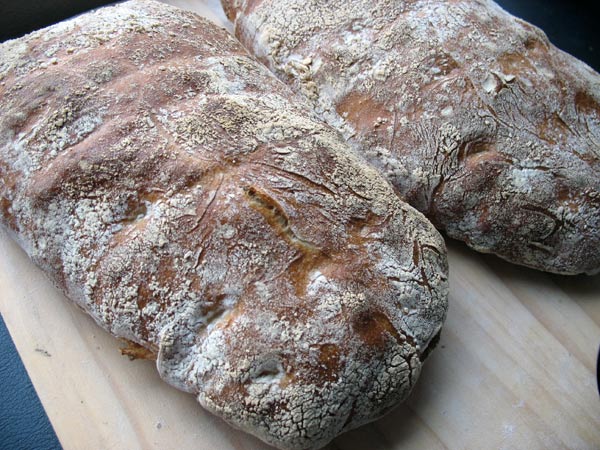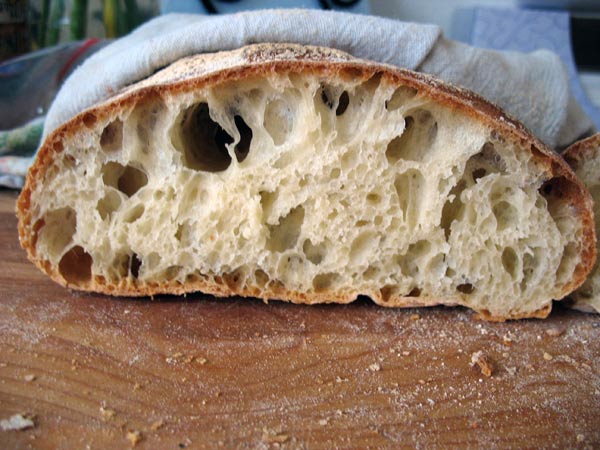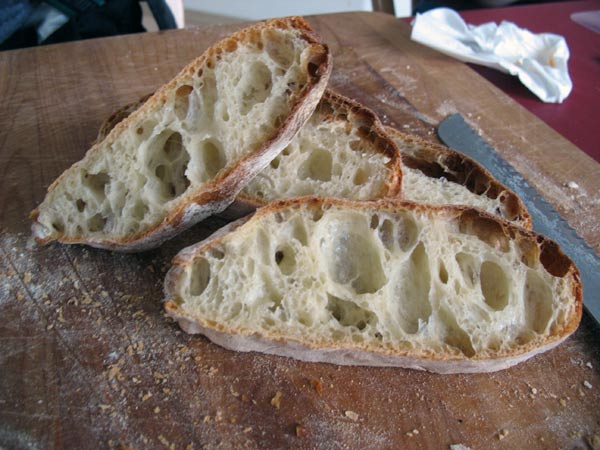My Ciabatta (sung to the tune of "My Sharona")

Oooh my little crusty one, my crunchy one.
Making you was awf'ly fun, My Ciabatta!
Your crumb is my fav'rite one, my fav'rite one.
When you gonna be done, My Ciabatta!

Ready to munch, don't want to wait
for you to cool. Cooling on the rack, wire rack,
Time to eat. My my my i yi woo! M M M My Ciabatta...

This was my best ciabatta to date. The two three things that seemed to make a difference were extremely slack dough (75% hydration), lower than usual yeast (cut it by half), and pressing it extremely thin before putting it in the oven. Other than those few changes, the dough and technique were basically the same as my daily bread.
Good stuff. More baking tomorrow.

Oooh my little crusty one, my crunchy one.
Making you was awf'ly fun, My Ciabatta!
Your crumb is my fav'rite one, my fav'rite one.
When you gonna be done, My Ciabatta!

Ready to munch, don't want to wait
for you to cool. Cooling on the rack, wire rack,
Time to eat. My my my i yi woo! M M M My Ciabatta...

This was my best ciabatta to date. The two three things that seemed to make a difference were extremely slack dough (75% hydration), lower than usual yeast (cut it by half), and pressing it extremely thin before putting it in the oven. Other than those few changes, the dough and technique were basically the same as my daily bread.
Good stuff. More baking tomorrow.
- Floydm's Blog
- Log in or register to post comments
WOW! Floyd, that is perfect!! What do you mean by "pressing it very thin before putting into the oven"? Wouldn't that completely degas it?
- Log in or register to post comments
Right before tossing it in the oven, I used my fingertips to dimple, press, and stretch it. I think it was no thicker than an inch at any place when I put it in the oven, which is much thinner than I've ever had it.
I did a bit of this when shaping it too: when I first shaped my rectangles they were about 2 inches thick, but then it dawned on me that even the final, baked loaves shouldn't be much taller than that. So, after 10 minutes, I went back and, using my fingertips, dimpled and streched it out until it was under an inch thick.
As far as I could tell, when dimpling I didn't pop any gas bubbled. It did agitate the dough enough to get a decent final fermentation out of it, despite the lack of shaping or degassing.
I'll certainly post an article about how to do it, if I can do it again. I need to succeed at least two time first though, so I can verify it wasn't just dumb luck!
- Log in or register to post comments
Wow.
That's a nice loaf of ciabatta. Which leads me to my question. This is the second time in a row I've made ciabatta, and the crumb looked like this.
 I wonder if it was because of a lack of dimpling, or something else. I used basically my daily bread recipe as well. I know I've read a term for this-but can't remember where or the causes. I only get these top heavy bubbles on the ciabatta. I've tried a recipe from TBBA, and same result. Any thoughts?
KP
I wonder if it was because of a lack of dimpling, or something else. I used basically my daily bread recipe as well. I know I've read a term for this-but can't remember where or the causes. I only get these top heavy bubbles on the ciabatta. I've tried a recipe from TBBA, and same result. Any thoughts?
KP
 I wonder if it was because of a lack of dimpling, or something else. I used basically my daily bread recipe as well. I know I've read a term for this-but can't remember where or the causes. I only get these top heavy bubbles on the ciabatta. I've tried a recipe from TBBA, and same result. Any thoughts?
KP
I wonder if it was because of a lack of dimpling, or something else. I used basically my daily bread recipe as well. I know I've read a term for this-but can't remember where or the causes. I only get these top heavy bubbles on the ciabatta. I've tried a recipe from TBBA, and same result. Any thoughts?
KP- Log in or register to post comments
I think you are on the money. That is what my ciabatta attempts have always looked like before. For example:
 As I said, it dawned on me right after shaping it that to get those massive bubbles that stretch from top to bottom, the loaf can't be much thicker than a couple of inches thick when baked. And if it is going to be only 2-3 inches thick when baked, it can't be more than an inch or so thick going into the oven, right? So... there may be other ways to keep it that thin without degassing other than dimpling, but dimpling seemed to work.
The gap at the top is usually a sign of poor surface tension ("the hole where the lazy baker sleeps") and seems to show up more often in slack doughs. Since you don't shape ciabatta to give it surface tension, holes are inevitable, and you want the dough to be slack. So I think you are on the right track, dough-wise. Just get it flatter and see what happens.
As I said, it dawned on me right after shaping it that to get those massive bubbles that stretch from top to bottom, the loaf can't be much thicker than a couple of inches thick when baked. And if it is going to be only 2-3 inches thick when baked, it can't be more than an inch or so thick going into the oven, right? So... there may be other ways to keep it that thin without degassing other than dimpling, but dimpling seemed to work.
The gap at the top is usually a sign of poor surface tension ("the hole where the lazy baker sleeps") and seems to show up more often in slack doughs. Since you don't shape ciabatta to give it surface tension, holes are inevitable, and you want the dough to be slack. So I think you are on the right track, dough-wise. Just get it flatter and see what happens.
 As I said, it dawned on me right after shaping it that to get those massive bubbles that stretch from top to bottom, the loaf can't be much thicker than a couple of inches thick when baked. And if it is going to be only 2-3 inches thick when baked, it can't be more than an inch or so thick going into the oven, right? So... there may be other ways to keep it that thin without degassing other than dimpling, but dimpling seemed to work.
The gap at the top is usually a sign of poor surface tension ("the hole where the lazy baker sleeps") and seems to show up more often in slack doughs. Since you don't shape ciabatta to give it surface tension, holes are inevitable, and you want the dough to be slack. So I think you are on the right track, dough-wise. Just get it flatter and see what happens.
As I said, it dawned on me right after shaping it that to get those massive bubbles that stretch from top to bottom, the loaf can't be much thicker than a couple of inches thick when baked. And if it is going to be only 2-3 inches thick when baked, it can't be more than an inch or so thick going into the oven, right? So... there may be other ways to keep it that thin without degassing other than dimpling, but dimpling seemed to work.
The gap at the top is usually a sign of poor surface tension ("the hole where the lazy baker sleeps") and seems to show up more often in slack doughs. Since you don't shape ciabatta to give it surface tension, holes are inevitable, and you want the dough to be slack. So I think you are on the right track, dough-wise. Just get it flatter and see what happens.- Log in or register to post comments
"Just get it flatter and see what happens."
I plan to, and will definately keep you "posted". Ha.
Thanks,
KP
- Log in or register to post comments
Floyd-
Did you use AP or bread flour? I use bread, but wonder if a softer flour might help as well.
KP
- Log in or register to post comments
If memory serves me right, I used store brand all-purpose flour for the poolish, King Arthur's Bread Flour for the rest.
- Log in or register to post comments
I am suitably impressed - turning several shades of green with envy - but very impressed! And the poetry isn't bad either.
- Log in or register to post comments
Hi Floyd,
I agree, the ciabatta's gotta be really thin before going into the oven. When I've dimpled the dough, my fingers do gently hit the surface beneath the loaves. The quick pressure didn't seem to degas at all.
Sylvia
In search of the perfect crust & crumb
- Log in or register to post comments
Floyd I looked at your dialy bread recipe but I wanted to know how did you adapt it for cibatta I really think your ciabatta here looks great and would like to know how you made it.
- Log in or register to post comments
Pretty much what I say at the end of the post: more water, less yeast, and a thinner shaped loaf.
- Log in or register to post comments